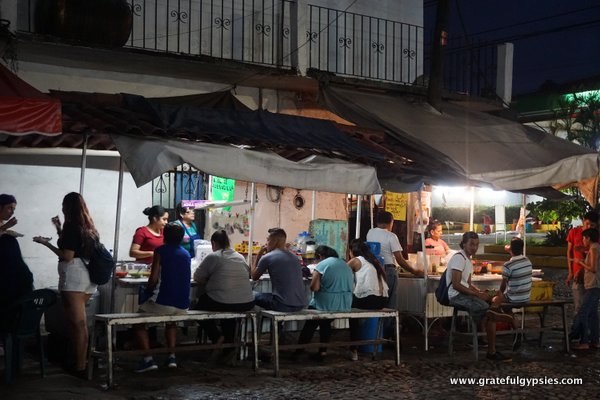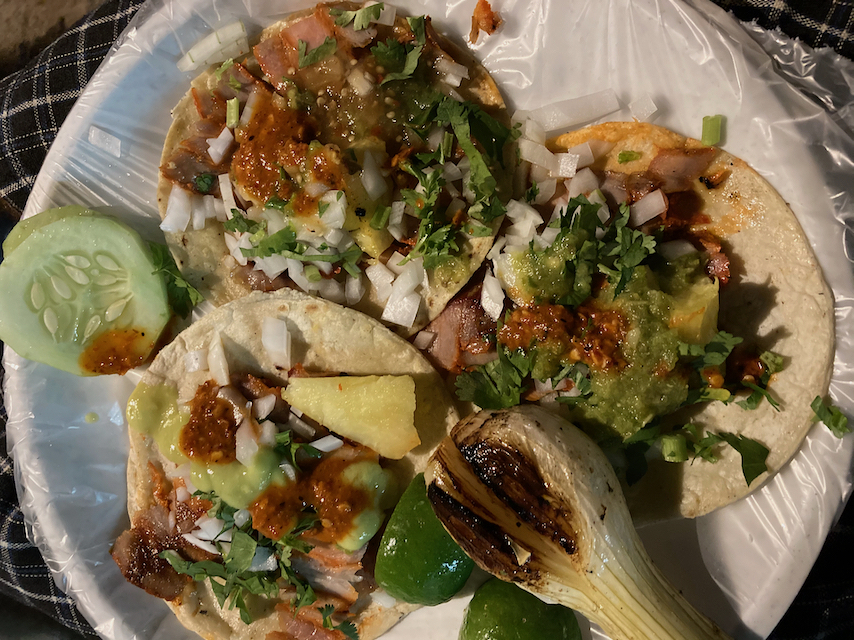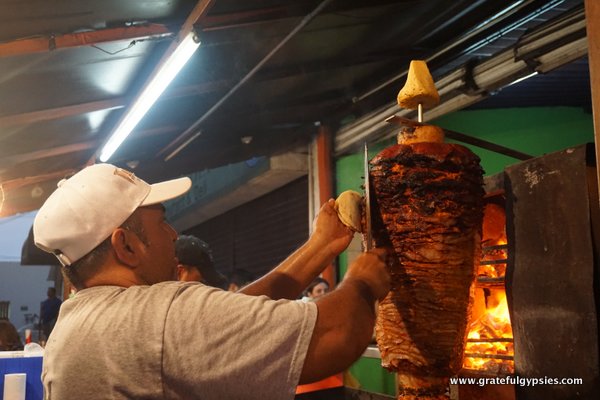¿Cuál es el mejor taco de México? Posted by sasha on May 26, 2021 in Food, Spanish Culture
El taco es el platillo más famoso de México. Hay muchos tipos diferentes de tacos, por ejemplo carnitas, barbacoa, birria, pescado, bistec, camarones y muchos más. Hoy vamos a responder a la pregunta – ¿Cuál es el mejor taco de México? (The taco is the most famous dish from Mexico. There are many different types of tacos, for example carnitas, barbacoa, birria, fish, steak, shrimp and many more. Today we’re going to answer the question – what is the best taco in Mexico?). But first, let’s get something clear…
¡Esto no es un taco!
If you grew up in the Midwest as I did, you probably grew up thinking this was a taco: a hard shell, ground beef, lettuce, tomato, cheese, and maybe some sour cream. Well, amigo, ¡Esto no es un taco! (This is not a taco!). In Mexico, when you eat something with a hard shell it’s called a tostada. It’s also round and not in the folded shape that a gringo taco comes in. If you put cheese on a taco, it’s called a quesadilla. Or if there’s cheese on a tostada, it’s called a volcane. You know, because the gooey melty cheese looks like a volcano!
When gringos make a “soft taco,” they usually use tortillas de harina (flour tortillas). You can find those in Mexico, but a vast majority of tacos use tortillas de maiz (corn tortillas). Most places even double down to add an extra layer for soaking up all the delicious juices and salsa. Plus, they’re more filling that way. More bang for your peso!
As for the fillings, you pretty much never find carne molida (ground beef) in a taco in Mexico. Instead of lechuga y tomate (lettuce and tomato), Mexicans put cebolla y cilantro (onion and coriander) on their tacos. If you want both on your taco, you need to say “Con todo” (With everything). And sour cream? Good luck even finding that in Mexico. Sure, there is crema, but it’s not quite the same and is never on the counter at a taco truck.
Ok now that we got that out of the way, let’s get down to business and try to answer this important question.
El mejor taco de México
¿Cuál es el mejor taco de México? La respuesta depende de la persona. A algunas personas les gusta la carne, a otras les gustan los mariscos y algunas son vegetarianas (What is the best taco in Mexico? The answer depends on the person. Some people like meat, other people like seafood, and some are vegetarians).
In addition, different regions of Mexico specialize in different types of tacos. Por ejemplo, en la costa, los tacos de pescado son muy populares (For example, on the coast, fish tacos are very popular). I eat fish tacos all the time where I live in Puerto Vallarta but usually stick to meat when I head inland to Guadalajara.
While it all depends on your personal taste and the area where you live, I would say there’s no doubt about what the most famous taco in Mexico is…
Tacos al pastor
You might say that tacos al pastor is el Rey de los Tacos (The King of Tacos). This is the taco that was introduced in the first episode of the popular Netflix series “Las Crónicas del Taco” (Taco Chronicles). It’s narrated in the first person as if the taco is talking, and al pastor very confidently claims “Yo soy tu taco de siempre” (I am your forever taco).
The show is amazing and I highly recommend watching it. I wrote a post about this and another Netflix show that are both great for practicing your listening and reading. Click here to check it out if you missed it.
The name literally translates to “shepherd style” because it comes from the shawarma that Lebanese immigrants brought to Mexico. Originally, the meat used was la carne de cordero (mutton), hence the “shepherd” name. This famous taco is made with la carne de cerdo (pork), which is cooked on a rotating trompo (spit).
La carne es preparada con un marinado tradicional mexicano llamado adobo (The meat is prepared with a traditional Mexican marinade called adobo). It’s a mixture of dried chilies, spices, and achiote paste. Each restaurant and taco truck adds its own unique flair to the marinade, so it’s always a different experience eating tacos al pastor.
Learn about tacos al pastor and practice your Spanish listening skills.
Perhaps the defining characteristic of tacos al pastor, though, is the use of la piña (the pineapple). A pineapple is placed atop the trompo, and it’s often sliced to let the juice drizzle down onto the meat and soak in while it cooks. It’s an honor to be el taquero who gets to man the trompo and it requires a special skill. You need to learn how to cut a little slice of pineapple and catch it inside the taco. It really is an art form!
As with most types of taco, al pastor is topped with diced onion and coriander. You can choose from a variety of salsas and other garnishes as well. Most taco trucks and restaurants have rábano y zanahoria (radish and carrot) and possibly some pickled jalapeños. Some of the salsas are nice and mild, while others will light your mouth on fire. You might want to ask them “¿Qué salsa es la más picante?” (Which salsa is the spiciest?).
It’s hard to say that they are the “best” tacos in Mexico, but tacos al pastor are most definitely my favorite. How about you? ¿Cuál es tu taco favorito? (What’s your favorite taco?). Leave a comment and let us know!

Build vocabulary, practice pronunciation, and more with Transparent Language Online. Available anytime, anywhere, on any device.







